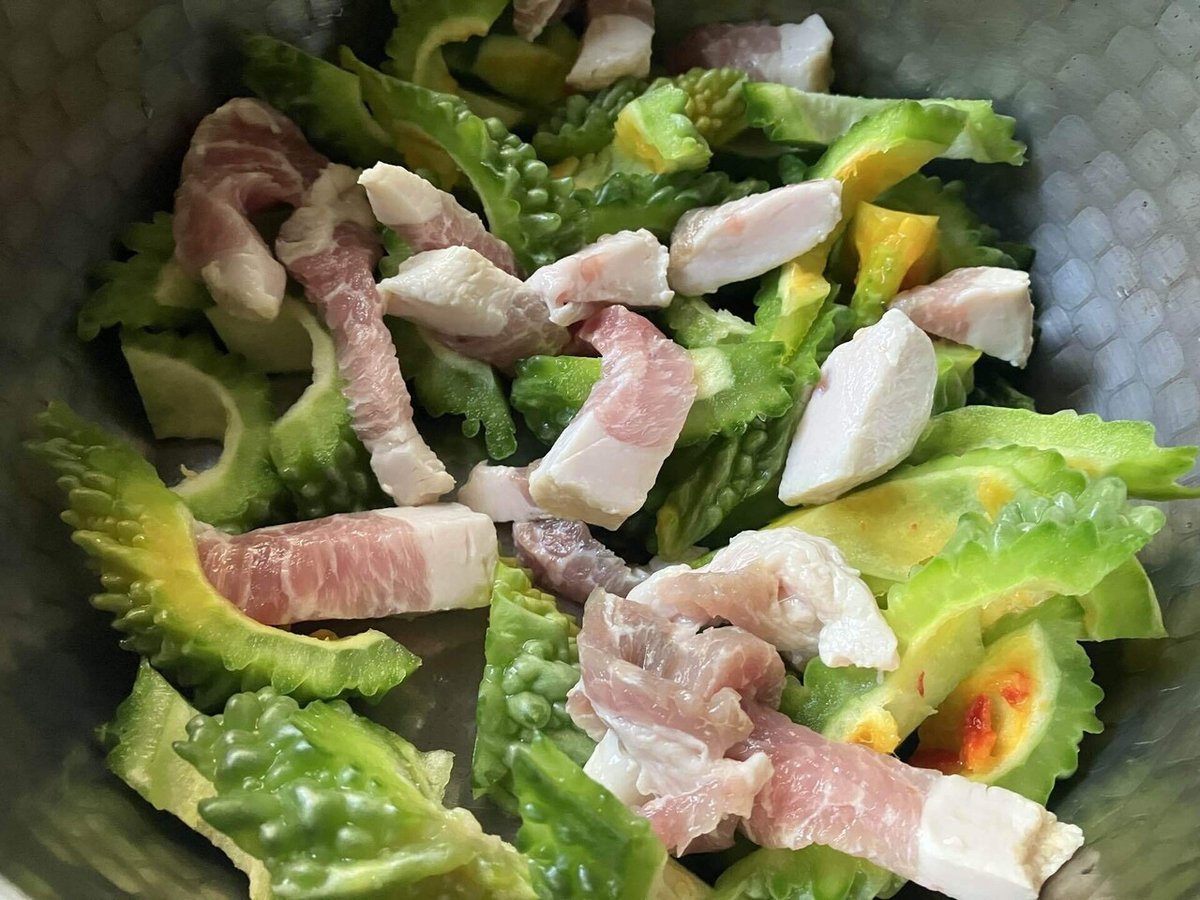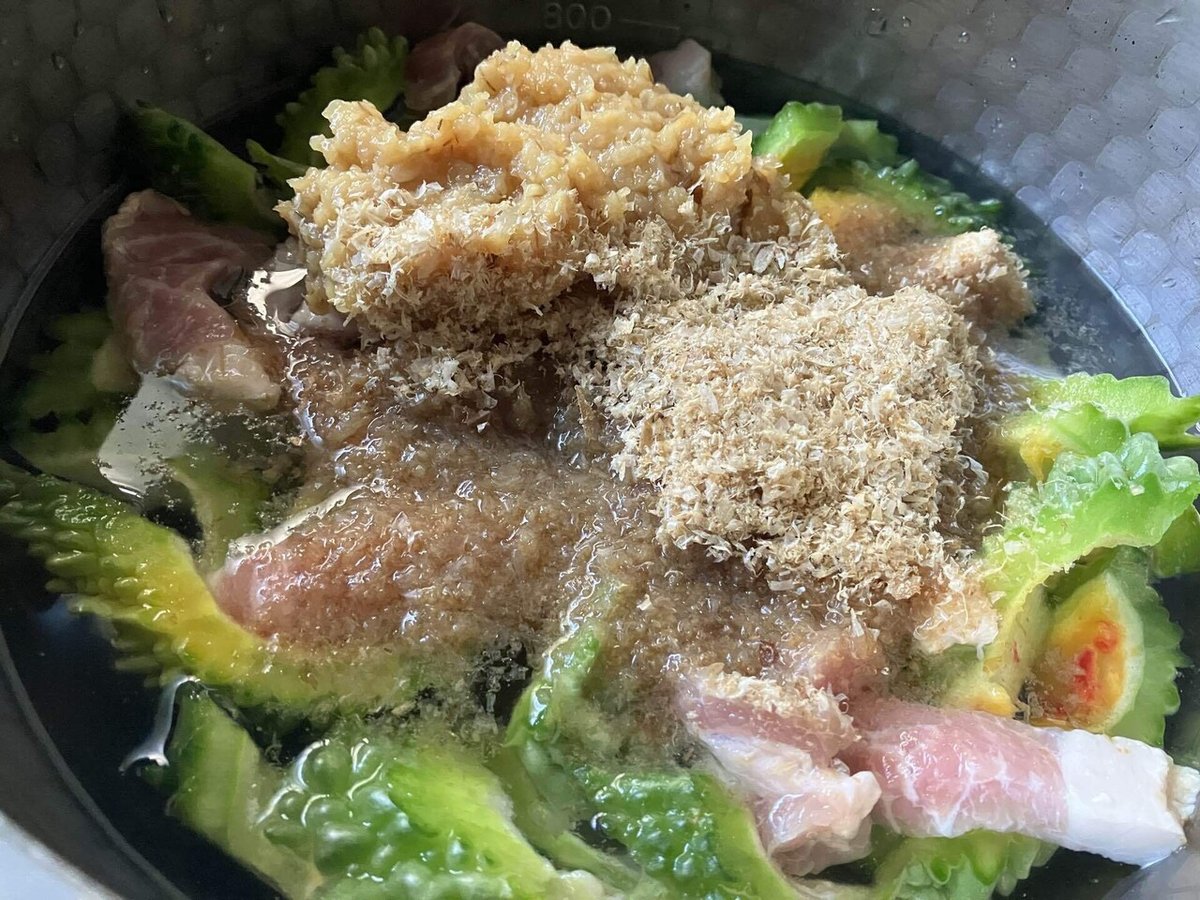
沖縄離島のオバーの味「ゴーヤウンブシー」Goya Unbushi, the taste of an old lady living on a remote island in Okinawa:おまかせ小品集 Chef's choice dishes collection
深夜食堂(ドラマの深夜食堂よりずっと前のお話)」でお出しした料理の小品集。材料がある限り何でも出してました。ほとんど即興だったので何百種類も作りましたが、お客様のエピソードを思い出せるものを少しづつ再現します(差し支えある話は多少脚色しています)。
A collection of small dishes served on "Midnight Diner" (a story that took place long before the TV drama "Midnight Diner"). We served anything as long as we had the ingredients. Since it was mostly improvisation, we made hundreds of dishes, but we will recreate little by little the ones that remind us of our customers' episodes (we have dramatized some of the more inappropriate stories).
おまかせの時間
The inspiration for the recipe
飲んだ後の締めのラーメンは美味しい。鎌倉の街には、深夜まで開いている街中華が一軒だけある(今は、多少選択肢が広いけど)。午前様まで飲んでしまうと、終着点はそこしか無い。僕もよく行った。選択肢のある昼間には絶対に行きたいと思わないほど、塩辛く油ぎった味なのだけど、酔った身体には極上の禁断の味なのだ。でも、間違いなく翌朝は後悔する。手足が浮腫んで、午後まで胃もたれが続くのだ。だから、僕が深夜食堂を開いた時は、随分感謝された。
僕のところでは、ピザやパスタ、ラーメンを作ってくれという、健啖家も多かったけど、「胃にもたれない。健康に良いもの」というリクエストも結構あった。後悔組は、件の街中華に行って、後悔し、翌日は僕のところでリカバリーするというサイクルを実行しているようだった。それなら飲まずに休肝日を作れば良いと思うかもしれないが、プロの飲み手としてはそうはいかないらしい。
僕は、野菜好きなので、深夜の店には珍しく、昼間のカフェなんかより、野菜をたくさん使う。外食では、炒め物や揚げ物が多いので、暴飲暴食で疲れてしまった人は、僕のところでは、漬物、和え物、煮物やお茶漬け、うどんや蕎麦を頼むことが多かった。ただ、店舗の運営上、そんなに在庫場所があるわけでは無いので、嵩張る野菜をそんなに常備してはおけない。いつしかお客さんが、食べたい野菜を持ち込んで来ることが多くなった。夏の持ち込みで一番多かったのはゴーヤ(苦瓜)だ。料理の仕方が分からず、持て余すからだ。
僕は、大昔、沖縄の旅館でアルバイトをしていたことがあり、そこの明治生まれのオバーに一通り沖縄料理を仕込まれた。彼女によると、ゴーヤチャンプルーは比較的新しい、居酒屋から流行り始めた料理で、家庭料理ではあまりやらなかったそうだ(四十年以上前に聞いた話なので、今は違うと思う)。その彼女が教えてくれたのが、ゴーヤを使った家庭料理「ゴーヤウンブシー」だ。とても優しい、体に染みるお惣菜だ。本来の沖縄料理には、こういう優しい味わいの家庭料理が沢山ある。
Ramen is delicious as a final dish after a night of drinking. In Kamakura, there is only one local Chinese restaurant that is open until late at night (though now there is a slightly wider choice). If you drink until the early hours of the morning, it is the only place to end your day. I often went there too. It is so salty and oily that you would never want to go there during the day when there are other options, but for a drunk body, it is the ultimate forbidden taste. However, you will definitely regret it the next morning. Your hands and feet will swell and your stomach will feel heavy until the afternoon. So when I opened Midnight Diner, people were very grateful. At my place, many big eaters asked me to make pizza, pasta, and ramen, but I also had a lot of requests for something that was healthy and didn't weigh them down. The regretful group seemed to go to the local Chinese restaurant, regret it, and then come to me the next day to recover. You might think that they should take a day off from drinking, but as a professional drinker, that's not the case.
I like vegetables, so I use more vegetables than a daytime cafe, which is rare for a late-night store. When eating out, I often eat stir-fried or fried foods, so people who are tired from overeating and drinking often order pickles, salads, simmered dishes, ochazuke, udon, and soba at my place. However, due to the operation of the store, we don't have much storage space, so we can't keep so many bulky vegetables on hand. Before I knew it, customers started bringing in the vegetables they wanted to eat. The most common bring-in in the summer was bitter melon. This is because I don't know how to cook it and it just goes to waste. A long time ago, I worked part-time at a ryokan in Okinawa, and the lady there, who was born in the Meiji era(Oba), taught me all the Okinawan dishes. According to her, goya chanpuru is a relatively new dish that started to become popular in izakayas, and it wasn't often cooked in homes (I heard this more than 40 years ago, so I don't think it's the same now). She taught me how to make "goya unbushi," a home-cooked dish using bitter melon. It's a very gentle, wholesome side dish. Authentic Okinawan cuisine includes many such home-cooked dishes with gentle flavors.

Today's Ingredients:
今日の素材:
プランターで収穫したゴーヤ(苦瓜)
スーチカ(塩漬けの豚バラ肉)
鰹削り節(ここでは、細かい破砕の削り節を使用)
味噌
黒糖
Goya (bitter melon) harvested from a planter
Suchika (salted pork belly)
Dried bonito flakes (finely crushed bonito flakes are used here)
Miso
Brown sugar
procedure:
つくり方:
苦瓜は種を取って、スライスしておく。
スーチカは、細い短冊に切っておく。
鍋に苦瓜とスーチカを入れ、ひたひたに水を注ぎ、味噌と黒糖、鰹削り節か粉末を入れて、落とし蓋をして、加熱する。
ときどきかき混ぜ、水気が少なくどろっとしてきたら、火を止める。
冷めても美味しく、冷蔵庫で5日程度保つので、作り置きしておいても良い。
Remove the seeds from the bitter melon and slice it.
Cut the suchika into thin strips.
Put the bitter melon and suchika in a pot, pour water until they are covered, add miso, brown sugar, and bonito flakes or powdered bonito flakes, cover with a lid, and heat.
Stir occasionally, and when the liquid has reduced and the mixture has thickened, turn off the heat.
It's delicious cold and will keep in the fridge for around 5 days, so it's good to make a large batch and store it in advance.





ヒントとバリエーション
Recipe tips and variation
ゴーヤは厚めに切った方が、味噌が染み込んで美味しい。
スーチカの代わりに、細切れ肉やチキアギ(さつま揚げか)などを入れても良い。肉や野菜を使わない場合は、戻し椎茸を使っても美味しい。椎茸の戻し汁や昆布粉などを使えば、鰹節なしのベジタリアン対応も可能。
ここでは、時短のため、粉末(破砕)の鰹節を使っているが、出し汁をとってあるなら、水の代わりに鰹出汁を入れても良い。
黒糖は、好みで。なくても良い。
家庭料理からは遠ざかるが、居酒屋風のややジャンキーな仕上げにするなら、合成の粉末出汁を使って、スーチカの代わりに、ポークランチョンミートやソーセージなどを使っても良い。
「ウンブシー」は琉球語で蒸し煮のこと。「ドゥル(泥)汁」状態に仕上がると、一番美味しくなるのだそうだ。沖縄では、ドゥルワカシー(田芋の煮込み)など、どろっと仕上げる料理が結構ある。
「ウンブシー」に向いた野菜はたくさんある。この季節、沖縄でよく使うのは、ナーベラー(若いヘチマ)、ユウガオ、ナシビー(ナス)、シブイ(冬瓜)など。熟れ過ぎの胡瓜、オクラ、ズッキーニも良く合う。
The bitter melon tastes better if it is cut thicker, so the miso can soak in.
You can use shredded meat or chikiagi (fish cakes or satsumaage) instead of suchika. If you don't want to use meat or vegetables, you can use rehydrated dried shiitake mushrooms. You can also make this a vegetarian dish without bonito flakes by using the rehydrated water from shiitake mushrooms or kelp powder.
Here, powdered (crushed) bonito flakes are used to save time, but if you have stock, you can use that instead of water.
Brown sugar is up to taste, but it's optional.
It's a bit of a departure from home cooking, but if you want a slightly more junky izakaya-style finish, you could use synthetic powdered dashi and use pork luncheon meat or sausage instead of suchika.
"Umbusi" means to stew in the Ryukyuan language. It is said to be most delicious when it is finished in a "duru (mud) soup" state. In Okinawa, there are quite a few dishes that are made thick, such as duruwakasi (stewed taro).
There are many vegetables that are suitable for "umbusi." The ones that are commonly used in Okinawa during this season are nabera (young loofah), yugao (calabash), nashibi (eggplant), and shibui (winter melon). Overripe cucumber, okra, and zucchini also go well with it.
Guide to where to get ingredients and equipment 材料と機材の入手先ガイド
※Amazonのアフェリエイトに参加しています。もしご購入の際はここからクリックしてご購入いただけると、コーヒー代の足しになるので、嬉しいです。ちなみに僕はコーヒー依存症です。
*I participate in Amazon affiliate programs. If you purchase this product by clicking here, it will help pay for my coffee, so I would be very happy. By the way, I am addicted to coffee.
この記事が気に入ったらサポートをしてみませんか?
